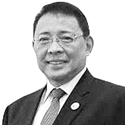
Signs And Wonders
By Diwa C. Guinigundo

It could have been one of Warren Buffet’s biggest opportunity losses, that deal with See’s Candies. “I almost blew the See’s purchase. The seller was asking for $30 million, and I was adamant about not going above $25 million.” Fortunately for Buffet, See’s seller agreed to his price. Buffet’s investment has given him over $2 billion in pre-tax income. With his investment, the chocolate factory has increased its annual earnings from $30 million in annual revenues to more than $380 million in sales and $80 million in profits.
In more meaningful ways, public spending on education, health, social services, is an investment in people and society, and every peso spent should produce returns many times over the sage of Omaha’s cumulative $2 billion plus. It is public spending on soft and hard infrastructure that could help develop the mind and brawn to establish the capital base of future growth. Public spending has a bigger footprint because it also mitigates poverty, hunger, and disease. If done properly, it also creates inclusive and sustainable, peaceful and climate-resilient communities.
In the same category, relief operations in the aftermath of the killer Typhoon Odette deliver corrective measures on infrastructure, emergency support to life and health by way of food and water, medicine and medical treatment.
Of course, it is easier to account for every peso investment in chocolate factories than to measure people’s ascent from poverty, illiteracy, and calamity. It breaks our heart to see young boys and girls helping their parents in Ubay, Bohol dig through piles of wooden and concrete piles of debris “to find anything they can use to rebuild their homes destroyed by Typhoon Odette” last week. Attending school and learning the three Rs will be their lowest priority; survival is the greatest. The greater Bohol area is a sad scenario of devastation, of the riverside Loboc area and its ancient churches, Chocolate hills, and even the small population of tarsiers.
Loss of tourism income is easy to estimate, but the value of lives lost and hopes dashed is priceless. Something as basic as water is non-existent in Bohol, food is dependent on donations. It was feared that looting might ensue as the food supply runs out, while water could not be pumped up because of loss of power. Cell coverage is not available. It is good that several candidates for national positions have announced the suspension of their political campaigns in favor of stepping up on relief operations, rallying their respective supporters to channel their support to the highly damaged areas in the Visayas and Mindanao. Bohol is just one painful example of Odette’s fury unleased in the Philippines like Surigao. This is not the time to court votes, this is the time to ensure voters could still survive to vote.
What else could the government do but declare a state of calamity in 31 provinces in six of the country’s 17 regions — Mimaropa, Western Visayas, Central Visayas, Eastern Visayas, Northern Mindanao, and Caraga. Our weather authorities documented that Odette was the strongest and most destructive typhoon this year, causing the death of around 400 persons and displacing over half a million Filipinos. Damage to infrastructure and the agricultural sector was placed at nearly P3.6 billion.
This Odette feels like déjà vu.
Very timely, this broadsheet came out yesterday with an extremely instructive chart on the 22 costliest and deadliest typhoons in the Philippines. Typhoon Yolanda of November 2013 topped the list with an estimated damage of more than P95 billion. After eight years, many parts of Tacloban, Samar, and northern Cebu remain scarred. The others in the top five were Ompong, P43.2 billion; Pablo, P39.95 billion; Glenda, P38.62 billion; and Pepeng, P27.2 billion. The least destructive on the list was Tisoy of November 2019, causing damage worth nearly P6 billion.
Yolanda also topped the list as the deadliest of these tropical cyclones with 6,300 deaths in its wake. Nearly as deadly was Uring which claimed 5,101 lives; Nitang, 1,363; Sendong, 1,268; and Pablo, 1,248. Kading was last in the deadliest list with 444.
There is nothing radical about the uncertainty of typhoons hitting the country’s area of responsibility. The ASEAN Disaster Reduction Center advises that there is an average of 20 typhoons in the Philippines every year, five of which are usually destructive in terms of damage to property and infrastructure as well as on human lives. This is something that should not surprise anybody, especially those in government. The Philippines is located along the typhoon belt in the Pacific. In fact, even earthquakes and volcanic eruptions should also be in the equations of the authorities because the Philippines is in the Pacific Ring of Fire. We are in the middle of a few oceans and we are therefore prone to periodic storm surge, sea level rise, landslides, flooding, and, yes, drought.
Any government worth the votes of the people should never be unnerved, or appear clueless, when it comes to the need to institutionalize emergency responses in terms of funding and logistics, national and local government coordination, and sharing of resources. Like a school exam, key parameters are known.
As a voter, the first question we should ask of all presidential contenders is how they intend to manage the Philippines’ unique vulnerability to the weather and climate change, from relief operations to rehabilitation efforts to reconstruction. If one candidate suggests a formation of a study group, serious voters should immediately strike that candidate out of consideration. If the candidate is very specific about the steps to be taken, complete with indicative timelines and budget, that candidate should lead us in the next six years.
While abstracting from the fundamental qualifications of presidential material like moral integrity and honesty, competence and good education, experience in public service — we should note that we have had presidents of outstanding intellect, unquestionable integrity, and distinguished public service. But today, we are still challenged to set up more efficient disaster management even as the disasters are virtually predictable — they will surely come. No different from a risk management system, it should be able to anticipate the ultimate appearance of calamities. We deserve a system that avoids scrounging for funds, rallying international support and donation. We are virtually reduced to mendicancy when we can afford to lose billions of pesos to corruption and bad governance.
Institutionalized disaster management will allow us to really treat the corresponding public spending as insurance against typhoons, earthquakes, volcanic eruptions, and other similar acts of nature. A quick look at the proposed 2022 national budget shows a P20 billion appropriation for the National Disaster Risk Reduction and Management Calamity Fund. In previous years, the fund was increased from budget transfers coming from overall savings. There were also continuing appropriations for capital outlays.
Obviously, these numbers are not enough because the government itself encourages the international community to lend a helping hand with cash, and donations in kind like food, water, and medicine. That is why, on top of its proposed loans from both the ADB and the World Bank for vaccine shots, the national government also signed a €250-million loan from France to fund local governments’ decentralized disaster response. Given the extent of the damage, it is safe to say the recovery will take years to complete. Relief is still most urgent; rehabilitation and reconstruction will not start until next year and perhaps beyond. Marawi is an excellent example of glacial progress.
With Omicron and Odette staring us in the face, and the economic recovery still uncertain, we could hardly have Chris Trapper’s black and blue Christmas. Relatively few are black and blue from shopping in the mall and braving the horrendous traffic.
Diwa C. Guinigundo is the former deputy governor for the Monetary and Economics Sector, the Bangko Sentral ng Pilipinas (BSP). He served the BSP for 41 years. In 2001-2003, he was alternate executive director at the International Monetary Fund in Washington, DC. He is the senior pastor of the Fullness of Christ International Ministries in Mandaluyong.